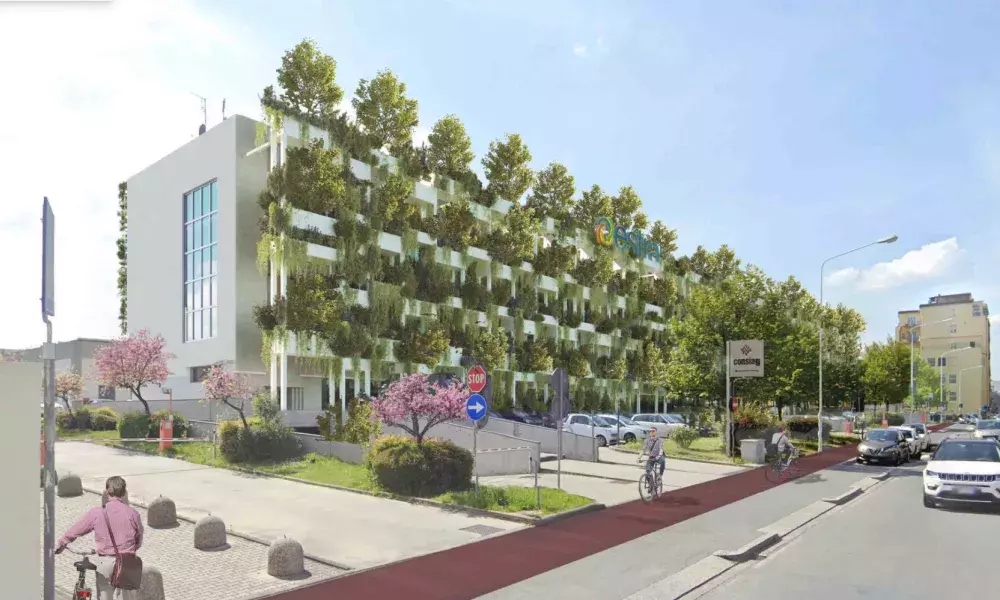
One of the pilot sites is developed in a private area: the ESTRA headquarter building and its surroundings located in a complex urban area overlooking the busiest public street in the city, with a daily passage of 50,000 vehicles. ESTRA has chosen to join this project not only for the protection of the environment, but also for the well-being of people, employees, citizens and the territory. Moreover, ESTRA is a national entity that operates throughout the national territory for the supply of natural gas, electricity, telecommunications and energy services, allowing to envision possible replications of the pilot test.
Within the ESTRA site, the theme is to promote, starting from the implementation of urban forestation strategies, the redevelopment of the neighbourhood both at an environmental level, for example through the ability of plants to store CO2 from the air and remove fine dust emitted by vehicular traffic, and at a social level, improving the physical and mental well-being of citizens and employees of the company.
Estra headquarter building pilot site. Image by Stefano Boeri Architetti
The project has been carried out by the PUJ partner, Stefano Boeri Architetti, with the aim of using state-of-the-art irrigation and rainwater harvesting systems and the selection of native plant essences. In this respect, particular attention was posed on high CO2 accumulation and storage capacity, removal of atmospheric pollutants and attraction for pollinating insects, as key points of the intervention for the benefit of increased comfort inside the buildings and wellbeing for the community. Amongst the challenges have been the increase of green permeable surfaces and the creation of green vertical and horizontal surfaces, the improvement of the energy efficiency of the buildings, insulating them laterally and on the roof, with facades and roofs shielded by vegetation. Furthermore, the creation of new social spaces, thanks to the transformation of car parks into common green areas and the reduction of buildings' exposure to air and noise pollution, as well as the opportunity to provide new hotspots for Prato's urban biodiversity have been occasions to generate innovative green connection hubs in the city's ecological corridor system.
"The main challenge of the Prato context is that we work on existing architecture and not on virgin or disused spaces,' says Stefano Boeri. 'We work on buildings that have their own ordinariness and that constitute a fundamental element of the contemporary urban landscape. Working on the new headquarters of Estra allows us to rethink the façades and the roof with a view to a strong greening, improving energy efficiency and a net reduction in air and noise pollution'.
Hence, the fundamental elements of the ESTRA pilot site have been:
- the construction of an urban forest to mitigate the impact of the high traffic boulevard just a few metres from the building, available to citizens;
- the construction of three types of innovative green façades, housing trees and shrubs around the entire perimeter of the building;
- the transformation of the unused roof into a green roof, making it an island of biodiversity, usable by employees as a place for socialising, small events or physical activity.
The strategic vision of the project area envisaged the demineralization of the area as the first step of the intervention, both on the ground and on the buildings: on the main and busiest road infrastructures by intervening with an environmental mitigation strategy with green works, providing planting of trees or shrubs, based on the section of the road and the height of the buildings present. The car parks have been entirely demineralised, replacing the waterproof flooring with a draining one and providing for the planting of trees or shrubs, or the construction of pergolas with climbing plants or photovoltaic panels.
The project developed for the Estra office building includes three different Nature-Based Solutions interventions involving the north façade, the south façade and the roof.
The design for the new main façade of the building presents a structure with a series of pots with trees and shrubs mitigating the noise and air pollution caused by the intense traffic of the boulevard in front. Various species of climbing plants will screen the south façade, which is subject to intense sun exposure, improving the building's environmental comfort.
The construction of the green façade created a plant screen that performs a function of mitigation and reduction of atmospheric pollution - through the absorption of the fine particles released by the road traffic and noise.
In particular, the project for the southern facade, characterised by large ribbon windows, involved the use of a specially designed brise-soleil system: the climbing plants run on steel cables up to cover the overall height of the building. The intervention on the north elevation composed a system of vases which, following the rhythm of the existing structure, were positioned in correspondence with the blind elements of the building's façade, creating space for significant portions of greenery without obstructing the lighting and ventilation inside the building.
Estra headquarter building facade. Image by Stefano Boeri Architetti
The existing roof, which was formerly unused, has been transformed into a green space for aggregation and corporate welfare for Consiag-Estra employees.
Due to the great construction and energy costs inflation the project was partially reduced and also received some delays due to bureaucratic processes connected to public procurement. Nevertheless, the intervention for the ESTRA building, in line with the vision of Prato Urban Jungle, is a project that put living nature at the centre of the planning objectives, to contribute to having a healthy and resilient city thanks to the use of Nature-based Solutions in architecture, through the creation of three types of green facades around the entire perimeter of the building to improve its energy efficiency.
About this resource
The Urban Innovative Actions (UIA) is a European Union initiative that provided funding to urban areas across Europe to test new and unproven solutions to urban challenges. The initiative had a total ERDF budget of €372 million for 2014-2020.
Similar content




